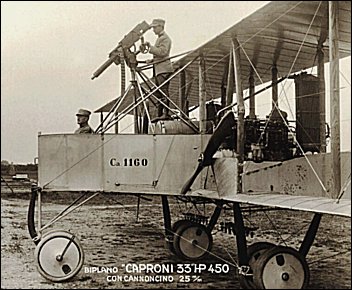 |
Caproni Ca.31915 |  |
| BOMBER | Virtual Aircraft Museum / Italy / Caproni |
 |
In 1913 pioneer aircraft designer Gianni Caproni designed a bomber of advanced concept powered by three engines, all contained in a central crew nacelle. Two engines drove tractor propellers by means of extension gearing and the third a pusher propeller at the rear of the nacelle. There was little official interest in the design and no construction was undertaken. However a Caproni prototype bomber flew for the first time in October 1914 with a 74.5kW Gnome rotary engine at the rear of the central nacelle driving a pusher propeller and two 59.6kW Gnomes conventionally mounted on the lower wings driving tractor propellers. Two booms extended aft of the wing engines to support the triple rudder tail-plane. The Italian government was slow to grasp the possibilities of the new design, but eventually a contract was signed for 12 Caproni 300HP bombers powered by three 74.5kW Fiat A.10 engines. A further 150 were delivered during the next two years. These aircraft were also known as Ca.1s and were followed by nine Ca.350HP machines (with the third engine replaced by a 112kW Isotta Fraschini) designated Ca.2. Ca.3 (or Ca.33) was in fact the alternative designation of the Ca.450HP, 299 of which were built between 1917 and 1919. Powered by three 112kW Isotta Fraschini V.4B engines, the Ca.3 proved the most successful Allied bomber of World War I, taking part in many outstanding raids. Normal bomb load was 200kg and defensive 7.7mm machine-guns were mounted over the nose cockpit and in a precarious open position which comprised a tubular metal structure incorporating a ladder leading from the rear of the central nacelle (just in front of the engine) to a gun ring just behind and slightly higher than the trailing edge of the upper wing centre section. Ca.3s equipped three bomber Gruppi by the end of 1917 and made attacks in numbers on Pola, Kotor naval base, railway junctions and troop concentrations. Licence production was undertaken in France by Robert Esnault-Pelterie, 83 examples being completed. Two French bomber Groupes cooperated with the Italian Ca.3-equipped XVIII Gruppo, which had been sent to the Western Front. They made damaging night raids on targets along the Marne as well as attacking troop concentrations near Amiens. In Italy Ca.3s hindered the Austrian advance from the Piave and gave strong support to the final victorious Italian offensive. With the revival of Italian air power by Mussolini and the formation of the Regia Aeronautica in 1923, the Ca.3 design was given a new lease of life. A handful of surviving Ca.3s bore witness to the longevity and effectiveness of the design and so orders were given to place it back in production in the Ca.3mod or Ca.36 versions. A number of minor improvements and production simplifications were incorporated and 153 were built over three years. Eighteen Ca.3mods took part in the 1925 military manoeuvres. The same year eight machines were sent to Libya in support of the reconquest of that territory. By the end of 1926, however, the last examples had been withdrawn from first-line service. Immediately post-war 20 Ca.1s and Ca.3s had been briefly utilised as passenger transports.
|  COMPANY PROFILE | ||||||||||||||||||||||||||||||||||||||||||||||||||||||
 |

|

